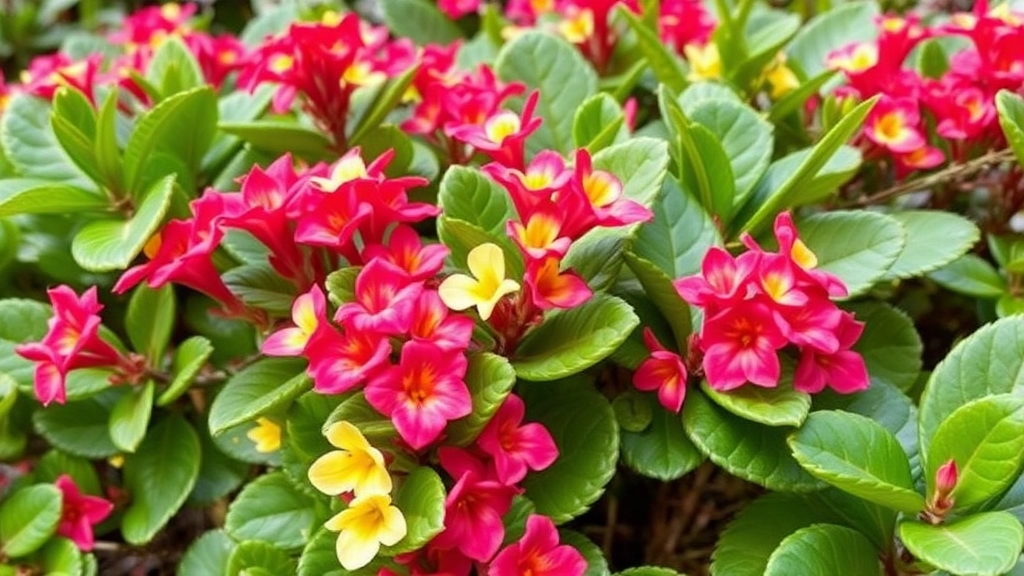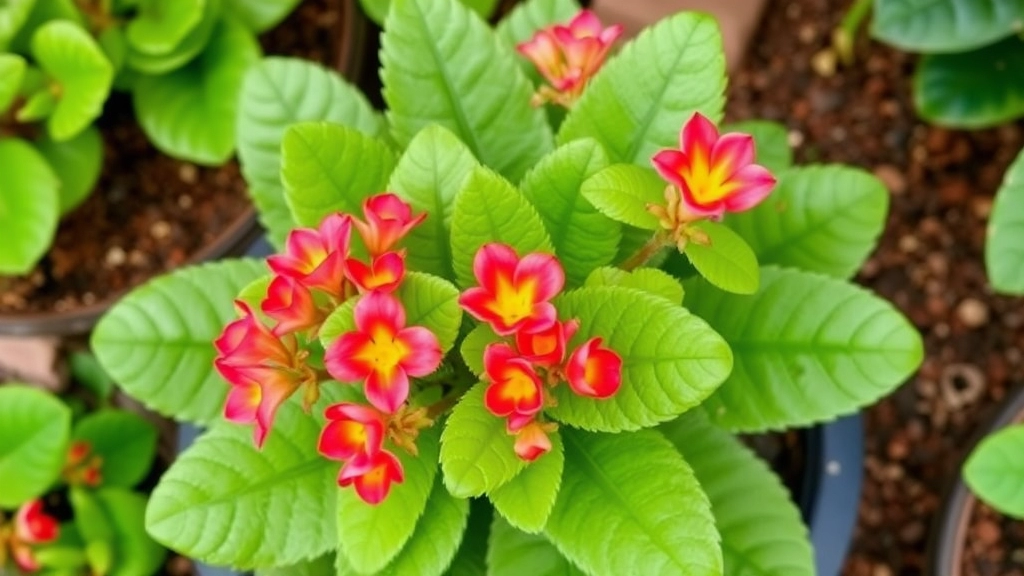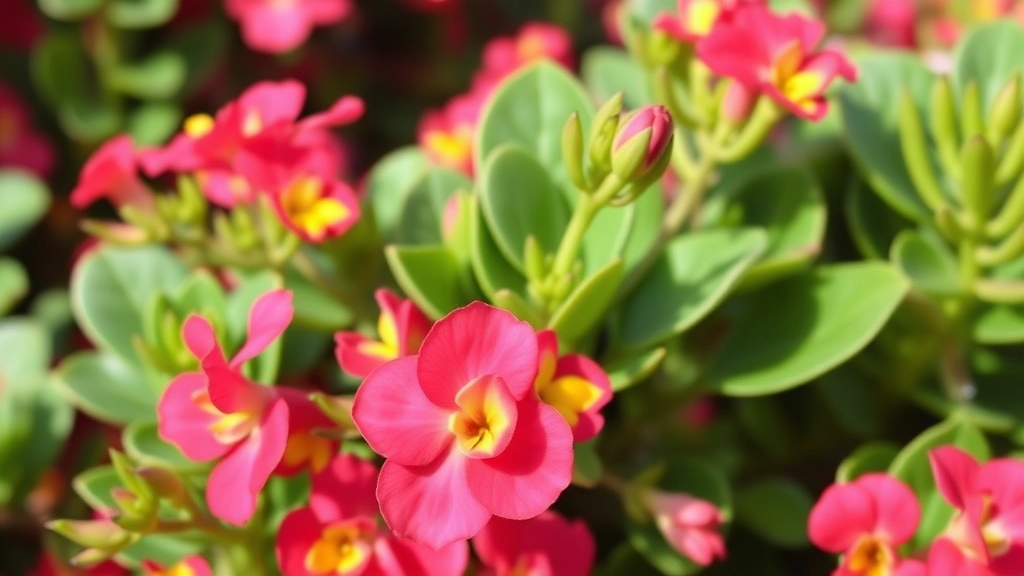Growing Flowering Kalanchoe in Hawaii
Growing flowering Kalanchoe in Hawaii is a rewarding experience for any plant enthusiast. Thanks to Hawaii’s tropical climate, these vibrant succulents thrive with minimal effort. Understanding the best conditions for growing Kalanchoe, such as the right amount of sunlight and watering practices, is key to ensuring they bloom beautifully year-round.
Caring for Kalanchoe in Hawaii
Caring for Kalanchoe in Hawaii involves adapting to the diverse microclimates found across the islands. Whether you’re in a humid coastal area or a cooler highland region, adjusting your care routine will help your Kalanchoe flourish. From propagation techniques to managing common pests, mastering these aspects will make your Hawaiian garden a Kalanchoe paradise.
When considering how to cultivate flowering Kalanchoe in Hawaii, you might wonder: What conditions do these vibrant plants thrive in?
Kalanchoe, known for its stunning blooms and resilience, flourishes in Hawaii’s warm, tropical climate. However, there are specific conditions that can enhance its growth and flowering potential.
### Ideal Light Conditions
– **Bright Indirect Light**: Kalanchoe prefers bright, indirect sunlight. Too much direct sun can scorch the leaves, while insufficient light may hinder flowering.
– **Morning Sun**: A few hours of morning sun can be beneficial, as it helps the plant absorb energy without the harshness of afternoon rays.
### Temperature and Humidity
– **Warm Temperatures**: Kalanchoe thrives in temperatures between 20°C to 30°C (68°F to 86°F).
– **Humidity Levels**: Moderate humidity is ideal. Hawaii’s natural humidity often suits Kalanchoe well, but ensure good air circulation to prevent fungal issues.
### Soil Requirements
– **Well-Draining Soil**: Use a potting mix that allows for excellent drainage. A cactus or succulent mix is often perfect for Kalanchoe.
– **pH Level**: Aim for a slightly acidic to neutral pH (6.0 to 7.0) for optimal nutrient absorption.
### Watering Practices
– **Allow to Dry**: Kalanchoe prefers to dry out between waterings. Overwatering can lead to root rot, a common issue in tropical climates.
– **Seasonal Adjustments**: During the blooming season, increase watering slightly, but reduce during dormancy.
### Fertilisation Tips
– **Balanced Fertiliser**: Use a balanced, water-soluble fertiliser every 4-6 weeks during the growing season to promote healthy blooms.
– **Avoid Over-Fertilising**: Too much fertiliser can damage the plant, so stick to recommended doses.
By providing the right light, temperature, soil, watering, and fertilisation, you’ll create an environment where your Kalanchoe can thrive and bloom beautifully. For more detailed care tips, you might find the [complete care guide for Kalanchoe Blossfeldiana](https://planthq.org/complete-care-guide-for-kalanchoe-blossfeldiana-succulent/) useful. Additionally, if you’re interested in exploring different species, check out this [comprehensive Kalanchoe species list for gardeners](https://planthq.org/comprehensive-kalanchoe-species-list-for-gardeners/).
Seasonal Blooming Patterns of Kalanchoe in Tropical Climates

Have you ever wondered why your Kalanchoe blooms at certain times of the year?
In tropical climates like Hawaii, the seasonal blooming patterns of Kalanchoe can be quite fascinating.
Key Factors Influencing Blooming:
- Light Exposure: Kalanchoe thrives in bright, indirect sunlight. Too much direct sun can scorch its leaves, while too little can delay blooming.
- Temperature: These plants prefer warmer temperatures, ideally between 20-25°C (68-77°F). In Hawaii, the consistent warmth plays a big role in encouraging blooms.
- Watering Routine: Overwatering can lead to root rot, while underwatering might stunt growth. A balanced approach is key.
Blooming Seasons:
- Winter to Spring: In many tropical regions, including Hawaii, Kalanchoe typically blooms from late winter to early spring. This is when they showcase their vibrant flowers, adding a splash of colour to your garden.
- Off-Peak Blooms: While the main blooming season is in the cooler months, you might notice sporadic flowers throughout the year, especially if conditions are just right.
Tips for Encouraging Blooms:
- Prune After Blooming: After your Kalanchoe finishes blooming, give it a good prune. This helps promote new growth and more flowers in the next cycle.
- Fertilize Sparingly: Use a balanced fertilizer during the growing season to boost blooms but avoid over-fertilising, as this can lead to lush foliage with fewer flowers.
- Stress for Blooming: Believe it or not, a bit of stress can encourage blooming. Reducing water slightly before the expected blooming season can trigger a more robust flower display.
When considering how to care for Kalanchoe in Hawaii, one must acknowledge the island’s diverse microclimates. Each microclimate presents unique challenges and opportunities for nurturing these vibrant plants.
### Understanding Microclimates
Hawaii’s microclimates can vary significantly from one area to another, influenced by factors like elevation, rainfall, and proximity to the ocean.
– **Coastal Areas:**
– Typically warmer and more humid.
– Ensure good drainage to prevent root rot.
– **High Elevation Regions:**
– Cooler temperatures and potential frost.
– Provide extra protection during colder nights.
– **Rainy Areas:**
– Higher moisture levels can lead to fungal diseases.
– Implement proper spacing for airflow and consider using fungicides if necessary.
### General Care Tips
To keep your Kalanchoe thriving, consider the following care tips tailored to Hawaii’s microclimates:
– **Light Requirements:**
– Kalanchoe loves bright, indirect sunlight.
– In shaded areas, supplement with grow lights if necessary.
– **Watering:**
– Allow the soil to dry out between watering.
– Adjust frequency based on humidity levels; coastal areas may require less frequent watering.
– **Soil Type:**
– Use a well-draining potting mix.
– Consider adding perlite or sand for improved drainage.
– **Fertilizing:**
– Feed with a balanced, water-soluble fertilizer during the growing season.
– Reduce feeding during the dormant winter months.
### Personal Experience
In my own garden, I noticed a remarkable difference in Kalanchoe health when I adjusted my care routine based on the local microclimate. For instance, in a coastal area, I found that reducing water frequency significantly improved the plant’s resilience against pests.
### Preparing for Seasonal Changes
As seasons shift, be mindful of how these changes affect your Kalanchoe.
– **Monitor Temperature Fluctuations:**
– Protect from extreme cold or heat by relocating pots as needed.
– **Adjust Watering Schedule:**
– Rainy seasons may necessitate less frequent watering.
By understanding and adapting to Hawaii’s diverse microclimates, you can ensure your Kalanchoe thrives beautifully. For more detailed information on caring for these plants, check out this [guide on Kalanchoe Mother of Thousands propagation](https://planthq.org/kalanchoe-mother-of-thousands-propagation-guide/) and learn about the [health benefits of Kalanchoe Pinnata](https://planthq.org/kalanchoe-pinnata-leaf-extract-health-benefits-bioactive-compounds/).
How to Propagate Kalanchoe Successfully in Hawaiian Gardens

Are you looking to expand your Kalanchoe collection in your Hawaiian garden?
Propagation can be an exciting and rewarding process, especially in the lush environment of Hawaii.
Methods of Propagation
There are several effective methods to propagate Kalanchoe, and each has its own charm:
- Leaf Cuttings:
- Select healthy leaves from a mature plant.
- Allow the cut end to dry for a few hours to form a callus.
- Place the leaf in well-draining soil, ensuring it’s upright.
- Stem Cuttings:
- Cut a healthy stem just below a node.
- Let the cutting dry for a day before planting.
- Insert the cutting into soil, burying it about an inch deep.
- Offsets:
- Look for small plantlets at the base of the parent plant.
- Gently separate them and plant them in their own pots.
Optimal Conditions for Successful Propagation
To ensure your propagation efforts are fruitful, consider these key factors:
- Soil: Use a well-draining potting mix. A cactus mix works well.
- Watering:
- Water sparingly. Overwatering can lead to rot.
- Allow the soil to dry out between waterings.
- Light:
- Provide bright, indirect sunlight. Direct sun can scorch the leaves.
- Temperature:
- Kalanchoe thrives in warm temperatures, ideally between 20°C to 25°C (68°F to 77°F).
Monitoring Growth
Once you’ve propagated your Kalanchoe, keep an eye on their progress:
- Signs of Rooting:
- Look for new growth or roots emerging from the soil.
- Transplanting:
- Once established, consider moving them to larger pots to encourage further growth.
Managing Invasiveness and Preventing Overgrowth in Outdoor Settings
When cultivating Kalanchoe in Hawaii, one of the pressing concerns is its potential for invasiveness. This hardy plant can thrive in various conditions, which makes it essential to manage its growth effectively.
Understanding Invasiveness
Kalanchoe species, particularly Kalanchoe daigremontiana, can spread rapidly if not monitored. This can lead to competition with native flora, disrupting local ecosystems. Here are some strategies to keep its growth in check:
- Regular Pruning:
- Trim back overgrown stems regularly.
- Remove any unwanted seedlings that appear.
- Controlled Planting:
- Use pots or raised beds to contain root systems.
- Ensure proper spacing to prevent crowding.
- Mulching:
- Apply organic mulch to suppress unwanted growth.
- This also helps retain moisture, benefiting the Kalanchoe.
- Monitoring Growth:
- Regularly inspect your garden for signs of overgrowth.
- Act quickly if you notice Kalanchoe encroaching on other plants.
By implementing these practices, you can enjoy the beauty of Kalanchoe without it overtaking your garden. For more detailed care instructions, check out our Kalanchoe paddle plant care guide.
Common Pests and Diseases Affecting Kalanchoe in Hawaii
So, you’ve got your Kalanchoe thriving in the Hawaiian sun. But what happens when unwelcome guests show up?
Let’s chat about the pests and diseases that can sneak into your garden and how to tackle them head-on.
FAQs on Flowering Kalanchoe in Hawaii
Why does my Kalanchoe bloom at certain times of the year?
Kalanchoe plants have specific blooming seasons, especially in tropical climates like Hawaii. They typically bloom from late winter to early spring, although sporadic blooms can occur throughout the year if conditions are optimal.
What factors influence the blooming of Kalanchoe?
Several factors influence the blooming of Kalanchoe:
- Light Exposure: They need bright, indirect sunlight.
- Temperature: Ideal temperatures range between 20-25°C (68-77°F).
- Watering Routine: Balanced watering is crucial; overwatering or underwatering can hinder blooming.
When is the main blooming season for Kalanchoe in Hawaii?
The main blooming season for Kalanchoe in Hawaii is from late winter to early spring. However, you may also see off-peak blooms throughout the year.
How can I encourage my Kalanchoe to bloom?
To encourage blooming, you can:
- Prune After Blooming: Pruning helps promote new growth and future blooms.
- Fertilize Sparingly: Use balanced fertilizer during the growing season.
- Stress for Blooming: Slightly reduce watering before the blooming season to trigger more flowers.
What are the methods to propagate Kalanchoe in Hawaiian gardens?
There are several methods to propagate Kalanchoe:
- Leaf Cuttings: Select healthy leaves, let them dry, and plant them in well-draining soil.
- Stem Cuttings: Cut a healthy stem, let it dry, and plant it about an inch deep in soil.
- Offsets: Separate small plantlets from the parent plant and pot them individually.
What are the optimal conditions for successful Kalanchoe propagation?
For successful propagation, ensure:
- Soil: Use a well-draining potting mix, such as cactus mix.
- Watering: Water sparingly and allow the soil to dry out between waterings.
- Light: Provide bright, indirect sunlight.
- Temperature: Maintain warm temperatures between 20°C to 25°C (68°F to 77°F).
How can I monitor the growth of propagated Kalanchoe?
To monitor growth:
- Signs of Rooting: Look for new growth or roots emerging from the soil.
- Transplanting: Once established, move them to larger pots to encourage further growth.
References
-
How to Propagate Kalanchoe Plants
-
How to Grow and Care for Kalanchoe
-
Kalanchoe: How to Grow and Care for Kalanchoe Plants
